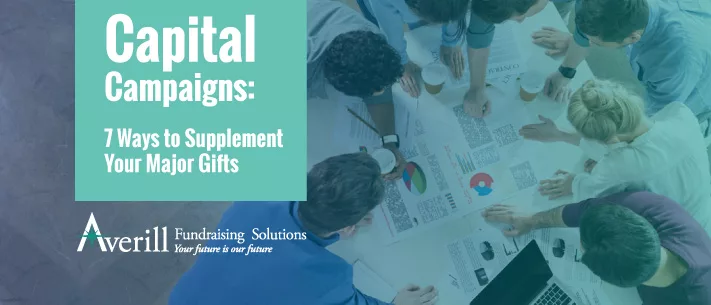
Capital Campaigns: If you’ve been involved with nonprofits or fundraising for any amount of time, odds are that you know the 80/20 or 90/10 rule. The ratio changes from organization to organization, but the sentiment is always the same: 80% of your fundraising comes from 20% of your community.
This is why major gift fundraising is so important, 20% of contributors are going to be responsible for 80% of your campaign’s success.
But the other 20% is still of vital importance. After a capital campaign, you can’t build 80% of a new research facility and call it a day. Your fundraising team needs to work on reaching out to the 80% of one-time, lapsed, or new supporters to raise the last 20%.
So how can you make sure that you’re effectively reaching those supporters to make sure you reach your goals? Here are our favorite strategies:
- Determine how much of your goal needs to come from smaller gifts.
- Take advantage of corporate philanthropy.
- Hold a giving day.
- Make giving easy through online giving tools.
- Focus on those who give recurring gifts.
- Conduct prospect research to find mid-range givers.
- Examine previous campaigns to find what works best.
Conducting a capital campaign is a long and serious endeavor, so read on to make sure you’re streamlining your fundraising efforts and engaging all levels of contributors for support.

1. Determine how much of your goal needs to come from smaller gifts.
While planning your capital campaign, your fundraising team broke down your overall fundraising goal into smaller, more manageable pieces to determine the cultivation and solicitation strategies necessary to reach that goal.
For example, you probably need four or five major givers to each give at a specific giving level in order to reach a certain portion of your goal. Therefore, your major gifts officers will find ten or so prospects with whom they want to build relationships.
The same practices apply to low- and mid-level supporters, as well.
The actual gift size that qualifies someone as a low-level or mid-level supporter varies from nonprofit to nonprofit, based on your fundraising capacity. Your gift range chart should indicate how many of each you need to reach your goals.
Next, consult your non-profit’s CRM to determine whether you could conceivably find all the support you need from existing supporter profiles in your database, or whether your team needs to conduct outreach to find new, untapped supporters in your community.
Once you know where you’re going to find the community behind your capital campaign, it’s time to plan your low- and mid-level supporter engagement tactics.

2. Take advantage of corporate philanthropy.
Is your nonprofit considering corporate philanthropy programs when finding support for your capital campaign? Corporate philanthropy is an underutilized resource for supplementing the gifts your campaign receives.
Matching gift programs are among the most common forms of corporate philanthropy.
Through these programs, a company will ‘match’ the gift that an employee makes to an organization by giving the same amount (or more) after the employee submits a matching gifts request.
When reaching out for mid-level gifts, consider if the supporter works for a top matching gift company. Someone might be able to be upgraded from low to mid, or mid to major giver status, depending on their employer’s gift matching policy.
Leverage corporate philanthropy programs and eligible supporters to help your nonprofit reach its capital campaign goals more efficiently.

3. Hold a giving day.
You’ve heard of #GivingTuesday fundraising campaigns—but have you thought about trying to make the popularity of a 24-hour giving period work specifically for your nonprofit?
You can hold a giving day, without more than a marketing campaign, a hashtag, and a social media following. Giving days are popular for low- to mid-range supporters because they’re convenient and approachable for a one-time giver.
First, choose a day. While #GivingTuesday is a great option, it is not the only one. This giving day could be anything important to your nonprofit—the anniversary of your nonprofit’s founding, your founder’s birthday, or a date important to your cause in general.
Then start your marketing campaign, specifically for this giving day! Social media is especially effective marketing for giving days. This is because posts have the ability to be shared at an incredible pace, spreading your message further and faster among strangers than direct mail could.
Some useful social media platforms to take advantage of for a giving day are:
- Twitter.
- Instagram.
- Facebook.
- LinkedIn.
All of these platforms use hashtags, which are a great way for your nonprofit to generate attention and engagement in the weeks leading up to your giving day. Create a hashtag that sums up the work you are trying to achieve through your capital campaign. For instance, a hashtag for a campaign to build a new school might be #centerforlearning.
Giving days are helpful for driving younger supporters to give to your nonprofit, as they tend to be the largest populations on social media.

4. Make giving easy through online giving tools.
Your nonprofit’s low- to mid-level supporters are less likely to attend informational luncheons or come for tours of your offices. Their connection to your nonprofit is based on their own passions, values, and bond with your mission.
All of these variables mean that your job is to make it as easy as possible for them to give as they feel so moved. One way to facilitate this giving is by offering a donations website in addition to traditional methods of giving.
More and more people access the internet as part of their daily lives, and many do so exclusively through their smartphones. Your nonprofit should ensure that giving online is an option for all levels of supporters.
This can mean different things, depending on your online presence, but some valuable resources are:
- A mobile-optimized online giving form.
- Text-to-give services.
- Recurring giving options.
- A matching gifts database.
Making it as easy as possible for your nonprofit to accept gifts through multiple platforms is a great way to ensure that you’re reaching as many of your lower- or mid-level supporters as possible.

5. Focus on those who give recurring gifts.
When trawling through your supporter database to determine who among your supporters could be called on to help with your capital campaign, pay special attention to those who give recurring gifts.
Recurring gifts indicate that the giver has a strong, ongoing connection with your organization and mission, and are willing to support that mission for the long haul.
When planning where you’ll find all your support for a capital campaign, focus on supporters who give regularly. What are some of the best ways to further engage these supporters?
- Open with an expression of gratitude for their ongoing support.
- Explain the purpose of your capital campaign.
- Ask if they would consider increasing the amount of their recurring gift for the entirety of your capital campaign, or making a separate, one-time contribution to the campaign fund.
Their ongoing support of your nonprofit indicates that they’ll be willing to help your nonprofit grow to new heights—which is exactly the point of your capital campaign!

6. Conduct prospect research to find mid-range givers.
Conducting prospect research is a highly important part of your major giving strategy: it helps your nonprofit determine who in your community is able to give the largest gifts, as well as who has a history of philanthropic behavior.
But if you think outside the box, you can find more givers than just major supporters through prospect research!
When conducting prospect research, bolster the ranks of your mid-range supporters with the following candidates:
- Those who have given philanthropically in the past, in the mid-size gift range.
- Those who have given to political campaigns that share similar values with your nonprofit.
- Those who work for the same employer or live in the same neighborhood as other mid-range givers.
Prospect research isn’t just for major gifts! Use the information you’ve already discovered to conduct more outreach for your cause and continue to expand your community of support.

7. Examine previous campaigns to find what works best.
If you find yourself struggling to find ways to connect and engage with low- and mid-range contributors, return to the strategies from previous campaigns and reconsider what drew those supporters to your nonprofit in the first place.
Ask yourself the following questions:
- Was there a particular image that went viral related to our cause, that may have triggered a cascade of gifts?
- Did a successful campaign have a seriously catchy slogan or hashtag?
- Do campaigns related to specific parts of your mission do better than others?
Once you’ve isolated the experience for the contributors that might be responsible for the success of those campaigns, do your best to utilize it in your capital campaign to attract that same groundswell of support from your community.
Engaging your low- to mid-level supporters doesn’t have to be difficult. Their support of your capital campaign is crucial to your success, so follow these simple best practices and make sure your nonprofit meets its goals.
Original article by Bob Happy of Averill Fundraising Solutions. For another helpful capital campaign resource, check out this capital campaign planning guide from Averill Fundraising Solutions.



